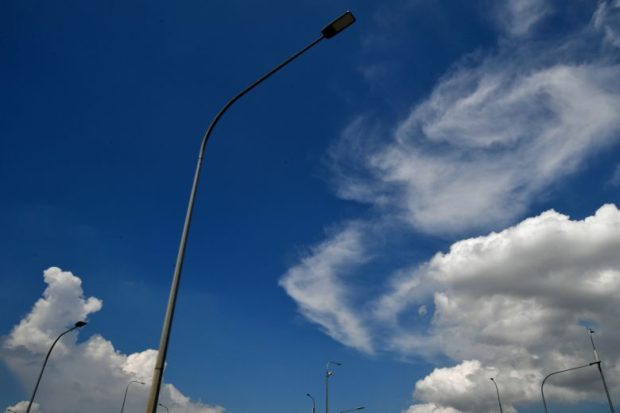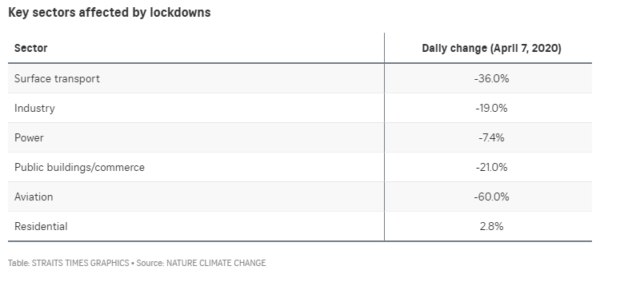Daily CO2 emissions plunge during COVID-19 pandemic lockdowns, with lessons for future—study

By April 2020, CO2 emissions had plunged to 2006 levels. The Straits Times/Asia News Network/LIM YAOHUI
SINGAPORE — Pandemic lockdowns slashed daily global emissions of carbon dioxide (CO2) by 17 percent, researchers said on Tuesday (May 19) in a detailed assessment of how the crisis affected the global economy.
By April this year, CO2 emissions had plunged to 2006 levels, the authors say, adding that the findings could help shape policies on cutting emissions to curb climate change.
Calls are growing globally for the trillions of dollars in stimulus spending to be directed to green programs to speed up the switch to a less polluting global economy and create jobs in new industries.
The multi-national group of scientists had examined data from 69 nations responsible for 97 per cent of mankind’s carbon emissions, and calculated the drop in CO2 compared with last year’s levels.
Carbon dioxide is the main greenhouse gas heating up the planet and the United Nations says emissions need to fall quickly this decade to try to keep warming to well below 2 deg C above pre-industrial levels.
Article continues after this advertisementThe study, published in Nature Climate Change, considered the impact of lockdowns, border closures and other restrictions on six sectors, including aviation, ground transport, power generation and households from January to April.
Article continues after this advertisementTransport, industry and power stations are the main sources of CO2 and air pollution, and emissions have been growing rapidly in recent decades.
Prior to the pandemic, the global economy pumped out about 100 million tonnes of CO2 a day – far more than nature can absorb, meaning it keeps accumulating in the atmosphere.
The authors found that nearly half the calculated drop in carbon emissions was the result of fewer cars, trucks and buses plying roads across many countries.
Aviation emissions also plunged, dropping by 60 percent by early April. This accounted for 10 per cent of the overall drop in CO2 emissions globally.
Emissions from the power generation sector dropped 7.4 percent, while household emissions rose 2.8 percent, reflecting the millions of people staying at home around the globe.
“Road transport was one of the most important sectors contributing to the fall in emissions, highlighting the large opportunities that would come from addressing transport as a key area for carbon mitigation,” said co-author Dr Pep Canadell, executive director of the Global Carbon Project, which closely monitors fossil fuel emission trends.
This could include speeding up electrification of transport or using green hydrogen as a fuel, plus more support for walking and cycling as part of a vision for low carbon, cleaner cities post-pandemic.
It could also encourage more plans to boost cycling, walking and public transport post-pandemic to try to cut air pollution and preserve blue skies.
“We have also had an extraordinary opportunity to assess what essential travel is, both for business and personal, and learnt that is possible in many instances that remote interactions are as efficient or more efficient than doing the traveling,” Dr Canadell told The Straits Times.
In total, daily CO2 emissions fell 17 million tonnes by early April.
That is the equivalent to the annual emissions of 3.7 million average cars, according to the US Environmental Protection Agency.
The depth of decline varied across nations, depending on the stringency of their lockdowns and other policies restricting movement.
In China, the decrease peaked at 24 percent, India at 26 percent, Indonesia 18 per cent and Italy 28 percent.
With countries now trying to ease restrictions, the question is how much CO2 emissions will drop by the end of the year.
The authors estimated emissions will drop between 4.2 and 7.5 percent, depending on how long restrictions or confinements last and economic activity remains depressed.
The big concern is what world leaders and businesses decide in the coming months, the authors said.
Will they step up and use the stimulus spending to achieve the goals of the UN’s Paris Climate Agreement to keep temperatures to well below 2 deg C and net-zero CO2 emissions by 2050?
“The extent to which world leaders consider the net-zero emissions targets and the imperatives of climate change when planning their economic responses to Covid-19 is likely to influence the pathway of CO2 emissions for decades to come,” the authors noted.
For more news about the novel coronavirus click here.
What you need to know about Coronavirus.
For more information on COVID-19, call the DOH Hotline: (02) 86517800 local 1149/1150.
The Inquirer Foundation supports our healthcare frontliners and is still accepting cash donations to be deposited at Banco de Oro (BDO) current account #007960018860 or donate through PayMaya using this link.
